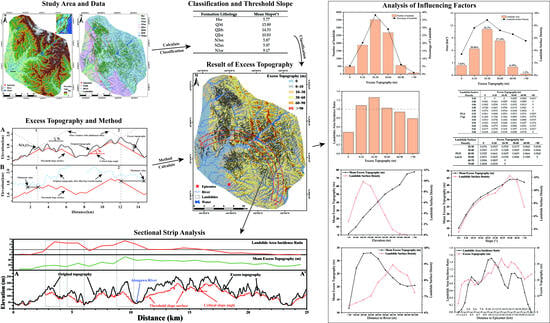Analysis of the Controlling Effect of Excess Topography on the Distribution of Coseismic Landslides during the Iburi Earthquake, Japan, on 6 September 2018
Abstract
:1. Introduction
2. Study Area
3. Data
3.1. Digital Elevation Model
3.2. Landslide Inventory
4. Methods
4.1. Excess Topography
4.2. Threshold Slope Value
5. Results
5.1. The Distribution of Excess Topography
5.2. Three Geomorphologic Factors Influencing the Distribution of the Coseismic Landslides and Excess Topography
5.3. Quantitative Analysis of Excess Topography for Coseismic Landslides
6. Discussion
6.1. Analysis of the Incident Ratio of the Coseismic Landslides in the Different Excess Topography Intervals
6.2. Influence of the Earthquake and Excess Topography on Coseismic Landslides
6.3. Influence of Coseismic Landslides on Mass Adjusting in the Future
6.4. Limitations of Analyzing the Distribution of Coseismic Landslides by Using Excess Topography
7. Conclusions
- (1)
- The excess topography had a strong control effect on the spatial distribution of the coseismic landslides in the study area. More than 94% of the landslides (approximately 28.23 km2) occurred in the areas with excess topography. Excess topography can be used for predicting coseismic landslides and conducting hazard analysis.
- (2)
- The excess topography spatially controls the possible locations of coseismic landslides, and whether a coseismic landslide occurs depends on the magnitude of the peak ground acceleration. In the study area, within 0–10 km of the epicenter, the development scale of the coseismic landslides increased with increasing excess topography. Beyond this range, the controlling effect of the excess topography on coseismic landslides was weaker.
- (3)
- The earthquake mainly induced shallow landslides with a relatively small thickness, which was generally smaller than the height of the excess topography in the main landslide development locations. This means that the earthquake-induced landslides did not completely remove the excess topography. Within a certain range, there is still the possibility of landslides in the future.
Author Contributions
Funding
Data Availability Statement
Acknowledgments
Conflicts of Interest
References
- Zhang, P.; Xu, C.; Ma, S.; Shao, X.; Tian, Y.; Wen, B. Automatic extraction of seismic landslides in large areas with complex environments based on deep learning: An example of the 2018 iburi earthquake, Japan. Remote Sens. 2020, 12, 3992. [Google Scholar] [CrossRef]
- Densmore, A.L.; Ellis, M.A.; Anderson, R.S. Landsliding and the evolution of normal-fault-bounded mountains. J. Geophys. Res. Solid Earth 1998, 103, 15203–15219. [Google Scholar] [CrossRef]
- Montgomery, D.R. Slope distributions, threshold hillslopes, and steady-state topography. Am. J. Sci. 2001, 301, 432–454. [Google Scholar] [CrossRef]
- Burbank, D. Rates of erosion and their implications for exhumation. Mineral. Mag. 2002, 66, 25–52. [Google Scholar] [CrossRef]
- Montgomery, D.R.; Brandon, M.T. Topographic controls on erosion rates in tectonically active mountain ranges. Earth Planet. Sci. Lett. 2002, 201, 481–489. [Google Scholar] [CrossRef]
- Roering, J.J.; Perron, J.T.; Kirchner, J.W. Functional relationships between denudation and hillslope form and relief. Earth Planet. Sci. Lett. 2007, 264, 245–258. [Google Scholar] [CrossRef]
- Korup, O.; Densmore, A.L.; Schlunegger, F. The role of landslides in mountain range evolution. Geomorphology 2010, 120, 77–90. [Google Scholar] [CrossRef]
- Larsen, I.J.; Montgomery, D.R.; Korup, O. Landslide erosion controlled by hillslope material. Nat. Geosci. 2010, 3, 247–251. [Google Scholar] [CrossRef]
- Larsen, I.J.; Montgomery, D.R. Landslide erosion coupled to tectonics and river incision. Nat. Geosci. 2012, 5, 468–473. [Google Scholar] [CrossRef]
- Su, L.; Hu, K.; Zhang, W.; Wang, J.; Lei, Y.; Zhang, C.; Cui, P.; Pasuto, A.; Zheng, Q. Characteristics and triggering mechanism of Xinmo landslide on 24 June 2017 in Sichuan, China. J. Mt. Sci. 2017, 14, 1689–1700. [Google Scholar] [CrossRef]
- Wang, Y.; Zhao, B.; Li, J. Mechanism of the catastrophic June 2017 landslide at Xinmo village, Songping river, Sichuan province, China. Landslides 2018, 15, 333–345. [Google Scholar] [CrossRef]
- Hu, K.; Wu, C.; Tang, J.; Pasuto, A.; Li, Y.; Yan, S. New understandings of the June 24th 2017 Xinmo landslide, Maoxian, Sichuan, china. Landslides 2018, 15, 2465–2474. [Google Scholar] [CrossRef]
- Chen, X.; Wang, M.; Chuan, Y.; Wei, Y.; Zhang, P. Topographic Controls on the Distribution of Coseismic Landslides: A Case Study Using the Coefficient of Variation of the 2014 Ludian, Yunnan, China, Ms6.5 Earthquake. Lithosphere 2022, 2021, 6678652. [Google Scholar] [CrossRef]
- Burbank, D.W.; Leland, J.; Fielding, E.; Anderson, R.S.; Brozovic, N.; Reid, M.R.; Duncan, C. Bedrock incision, rock uplift and threshold hillslopes in the northwestern Himalayas. Nature 1996, 379, 505–510. [Google Scholar] [CrossRef]
- Blöthe, J.H.; Korup, O.; Schwanghart, W. Large landslides lie low: Excess topography in the Himalaya-Karakoram ranges. Geology 2015, 43, 523–526. [Google Scholar] [CrossRef]
- Perron, J.T. Numerical methods for nonlinear hillslope transport laws. J. Geophys. Res. Earth Surf. 2011, 116. [Google Scholar] [CrossRef]
- Wang, W.N.; Wu, H.L.; Nakamura, H.; Wu, S.C.; Ouyang, S.; Yu, M.F. Mass movements caused by recent tectonic activity: The 1999 Chi-chi earthquake in central Taiwan. Isl. Arc 2003, 12, 325–334. [Google Scholar] [CrossRef]
- Khazai, B.; Sitar, N. Evaluation of factors controlling earthquake-induced landslides caused by Chi-Chi earthquake and comparison with the Northridge and Loma Prieta events. Eng. Geol. 2004, 71, 79–95. [Google Scholar] [CrossRef]
- Sato, H.P.; Hasegawa, H.; Fujiwara, S.; Tobita, M.; Koarai, M.; Une, H.; Iwahashi, J. Interpretation of landslide distribution triggered by the 2005 Northern Pakistan earthquake using SPOT 5 imagery. Landslides 2007, 4, 113–122. [Google Scholar] [CrossRef]
- Wang, H.; Sassa, K.; Xu, W. Analysis of a spatial distribution of landslides triggered by the 2004 Chuetsu earthquakes of Niigata Prefecture, Japan. Nat. Hazards 2007, 41, 43–60. [Google Scholar] [CrossRef]
- Gorum, T.; Fan, X.; van Westen, C.J.; Huang, R.Q.; Xu, Q.; Tang, C.; Wang, G. Distribution pattern of earthquake-induced landslides triggered by the 12 May 2008 Wenchuan earthquake. Geomorphology 2011, 133, 152–167. [Google Scholar] [CrossRef]
- Qi, S.; Xu, Q.; Zhang, B.; Zhou, Y.; Lan, H.; Li, L. Source characteristics of long runout rock avalanches triggered by the 2008 Wenchuan earthquake, China. J. Asian Earth Sci. 2011, 40, 896–906. [Google Scholar] [CrossRef]
- Chen, X.; Zhou, Q.; Liu, C. Distribution pattern of coseismic landslides triggered by the 2014 Ludian, Yunnan, China Mw6. 1 earthquake: Special controlling conditions of local topography. Landslides 2015, 12, 1159–1168. [Google Scholar]
- Zhou, S.; Chen, G.; Fang, L. Distribution pattern of landslides triggered by the 2014 Ludian earthquake of China: Implications for regional threshold topography and the seismogenic fault identification. ISPRS Int. J. Geo-Inf. 2016, 5, 46. [Google Scholar] [CrossRef]
- Gallo, F.; Lavé, J. Evolution of a large landslide in the High Himalaya of central Nepal during the last half-century. Geomorphology 2014, 223, 20–32. [Google Scholar] [CrossRef]
- Amante, C.; Eakins, B.W. ETOPO1 Arc-Minute Global Relief Model: Procedures, Data Sources and Analysis. 2009. Available online: https://repository.library.noaa.gov/view/noaa/1163 (accessed on 9 June 2023).
- Moreno, T.; Wallis, S.R.; Kojima, T.; Gibbons, W. The Geology of Japan; Geological Society of London: London, UK, 2016. [Google Scholar]
- Gou, T.; Huang, Z.; Zhao, D.; Wang, L. Structural heterogeneity and anisotropy in the source zone of the 2018 Eastern Iburi earthquake in Hokkaido, Japan. J. Geophys. Res. Solid Earth 2019, 124, 7052–7066. [Google Scholar] [CrossRef]
- Kobayashi, H.; Koketsu, K.; Miyake, H. Rupture process of the 2018 Hokkaido Eastern Iburi earthquake derived from strong motion and geodetic data. Earth Planets Space 2019, 71, 63. [Google Scholar] [CrossRef]
- Okada, A.; Ikeda, Y. Active faults and neotectonics in Japan. Quat. Res. (Daiyonki-Kenkyu) 1991, 30, 161–174. [Google Scholar] [CrossRef]
- Iwahashi, J. 1: 25,000-Scale Active Fault Map in Urban Areas Published by GSI. Bull. Geospat. Inf. Auth. Jpn. 2010, 58, 29–37. [Google Scholar]
- Ministry of Land, Infrastructure, Transport and Tourism, Hokkaido Development Bureau. Response to Disasters on the 2018 Hokkaido Eastern Iburi Earthquake; Ministry of Land, Infrastructure, Transport and Tourism, Hokkaido Development Bureau: Sapporo, Japan, 2018. (In Japanese)
- Kasai, M.; Yamada, T. Topographic effects on frequency-size distribution of landslides triggered by the Hokkaido Eastern Iburi Earthquake in 2018. Earth Planets Space 2019, 71, 89. [Google Scholar] [CrossRef]
- Yamagishi, H.; Yamazaki, F. Landslides by the 2018 hokkaido iburi-tobu earthquake on september 6. Landslides 2018, 15, 2521–2524. [Google Scholar] [CrossRef]
- Shao, X.; Ma, S.; Xu, C.; Zhang, P.; Wen, B.; Tian, Y.; Zhou, Q.; Cui, Y. Planet image-based inventorying and machine learning-based susceptibility mapping for the landslides triggered by the 2018 Mw6. 6 Tomakomai, Japan Earthquake. Remote Sens. 2019, 11, 978. [Google Scholar] [CrossRef]
- Schwanghart, W.; Kuhn, N.J. TopoToolbox: A set of Matlab functions for topographic analysis. Environ. Model. Softw. 2010, 25, 770–781. [Google Scholar] [CrossRef]
- Anderson, M.; Richards, K.; Kneale, P. The role of stability analysis in the interpretation of the evolution of threshold slopes. Trans. Inst. Br. Geogr. 1980, 5, 100–112. [Google Scholar] [CrossRef]
- Schmidt, K.M.; Montgomery, D.R. Rock mass strength assessment for bedrock landsliding. Environ. Eng. Geosci. 1996, 2, 325–338. [Google Scholar] [CrossRef]
- Bennett, G.L.; Miller, S.R.; Roering, J.J.; Schmidt, D.A. Landslides, threshold slopes, and the survival of relict terrain in the wake of the Mendocino Triple Junction. Geology 2016, 44, 363–366. [Google Scholar] [CrossRef]
- Yalcin, A. GIS-based landslide susceptibility mapping using analytical hierarchy process and bivariate statistics in Ardesen (Turkey): Comparisons of results and confirmations. Catena 2008, 72, 1–12. [Google Scholar] [CrossRef]
- Qi, S.; Xu, Q.; Liu, C.; Zhang, B.; Liang, N.; Tong, L. Slope Instabilities in the Severest Disaster Areas of 5.12 Wenchuan Earthquake. J. Eng. Geol. 2009, 17, 39–49. [Google Scholar]
- Chen, X.L.; Liu, C.G.; Wang, M.M.; Zhou, Q. Causes of unusual distribution of coseismic landslides triggered by the Mw 6.1 2014 Ludian, Yunnan, China earthquake. J. Asian Earth Sci. 2018, 159, 17–23. [Google Scholar] [CrossRef]
- Hakan, T.; Luigi, L. Completeness index for earthquake-induced landslide inventories. Eng. Geol. 2020, 264, 105331. [Google Scholar] [CrossRef]
- Roering, J. Landslides limit mountain relief. Nat. Geosci. 2012, 5, 446–447. [Google Scholar] [CrossRef]
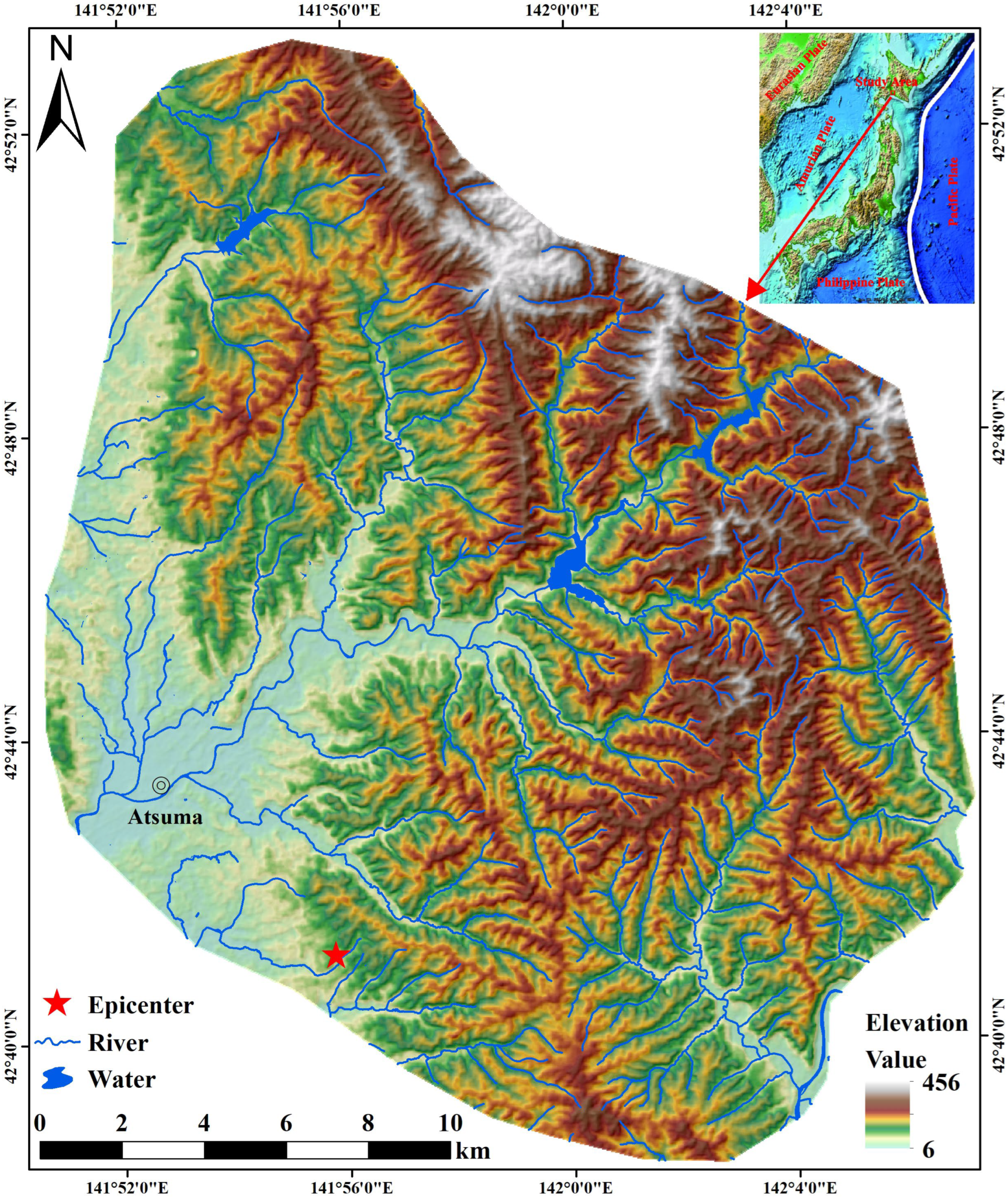
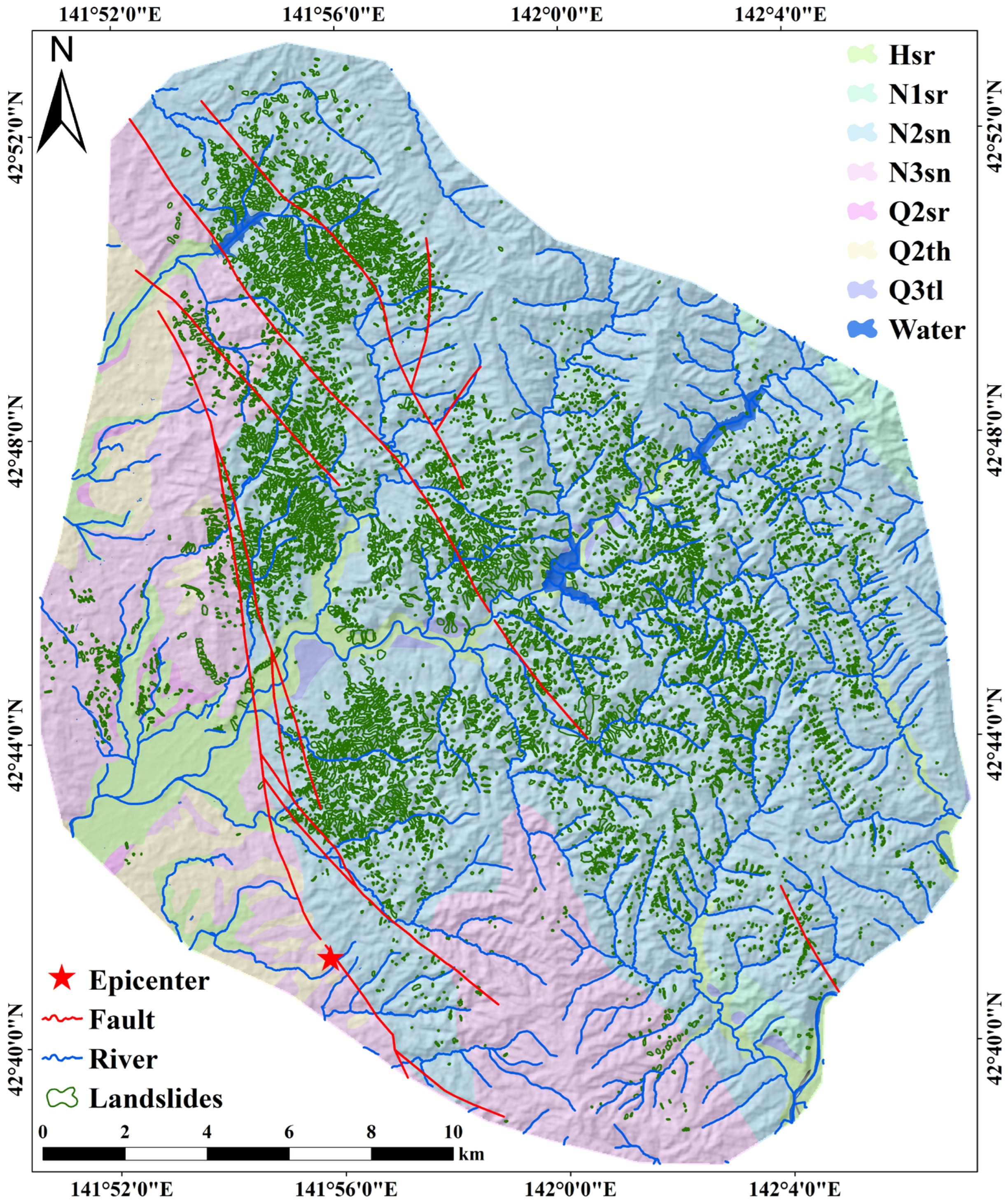


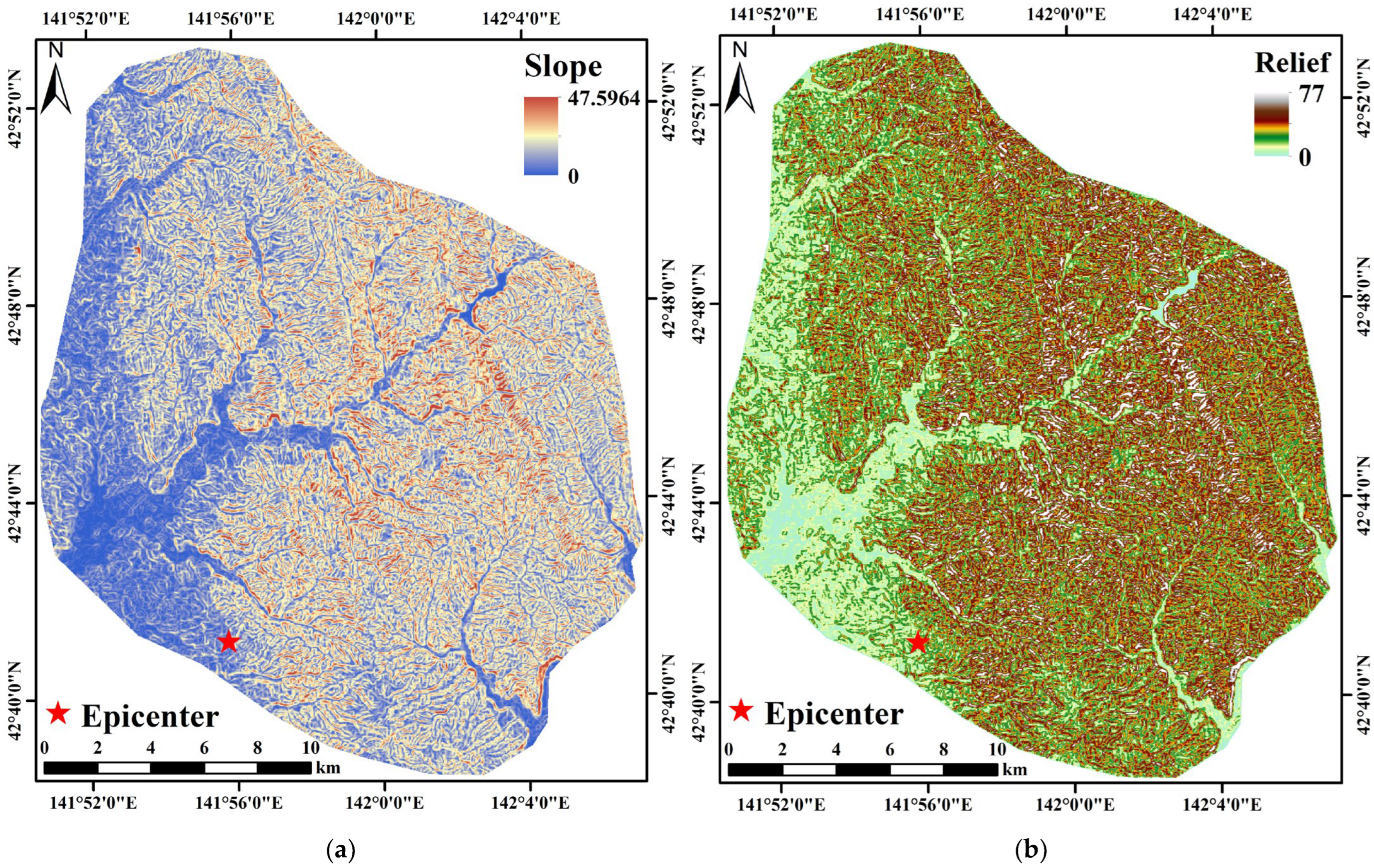
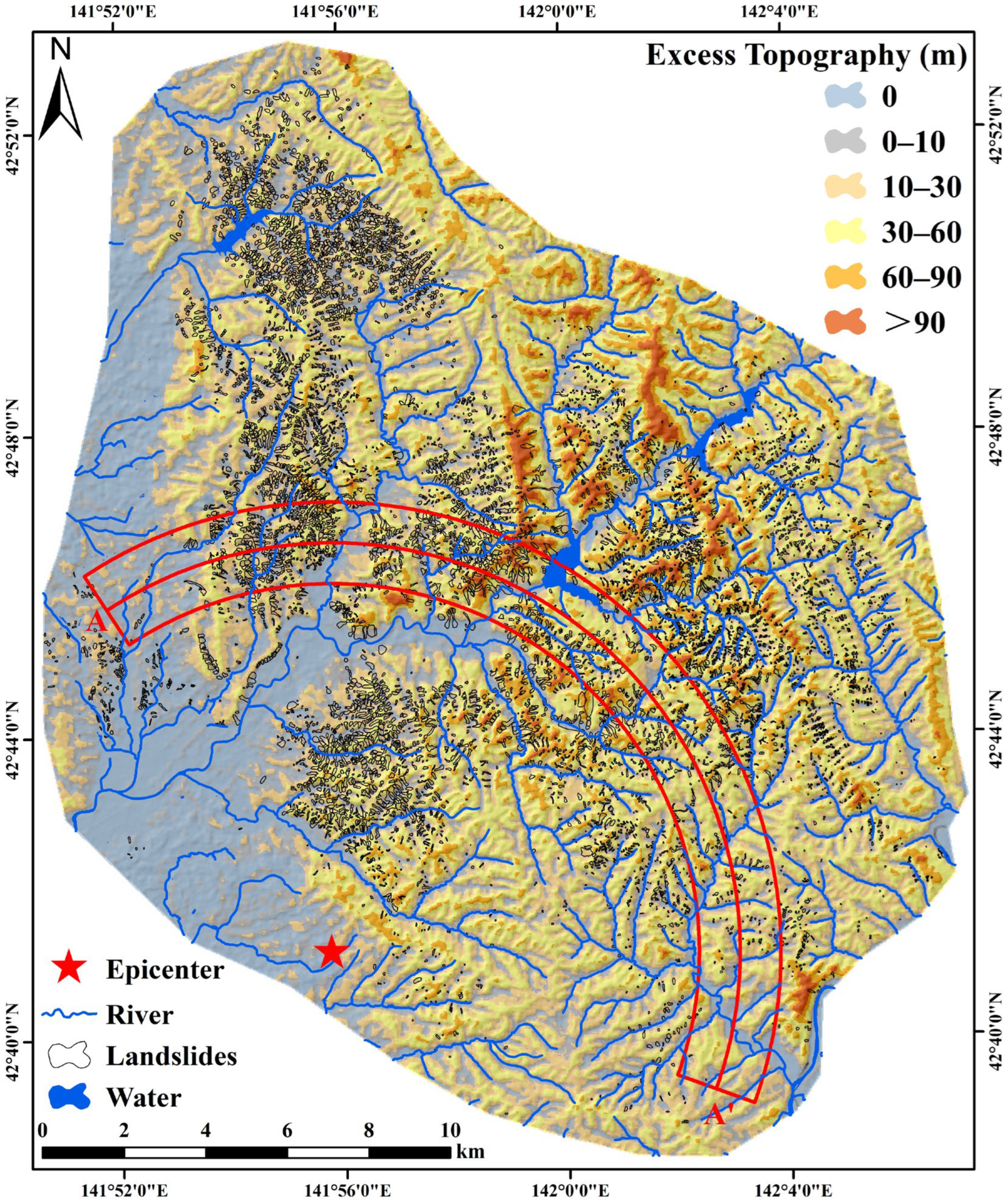
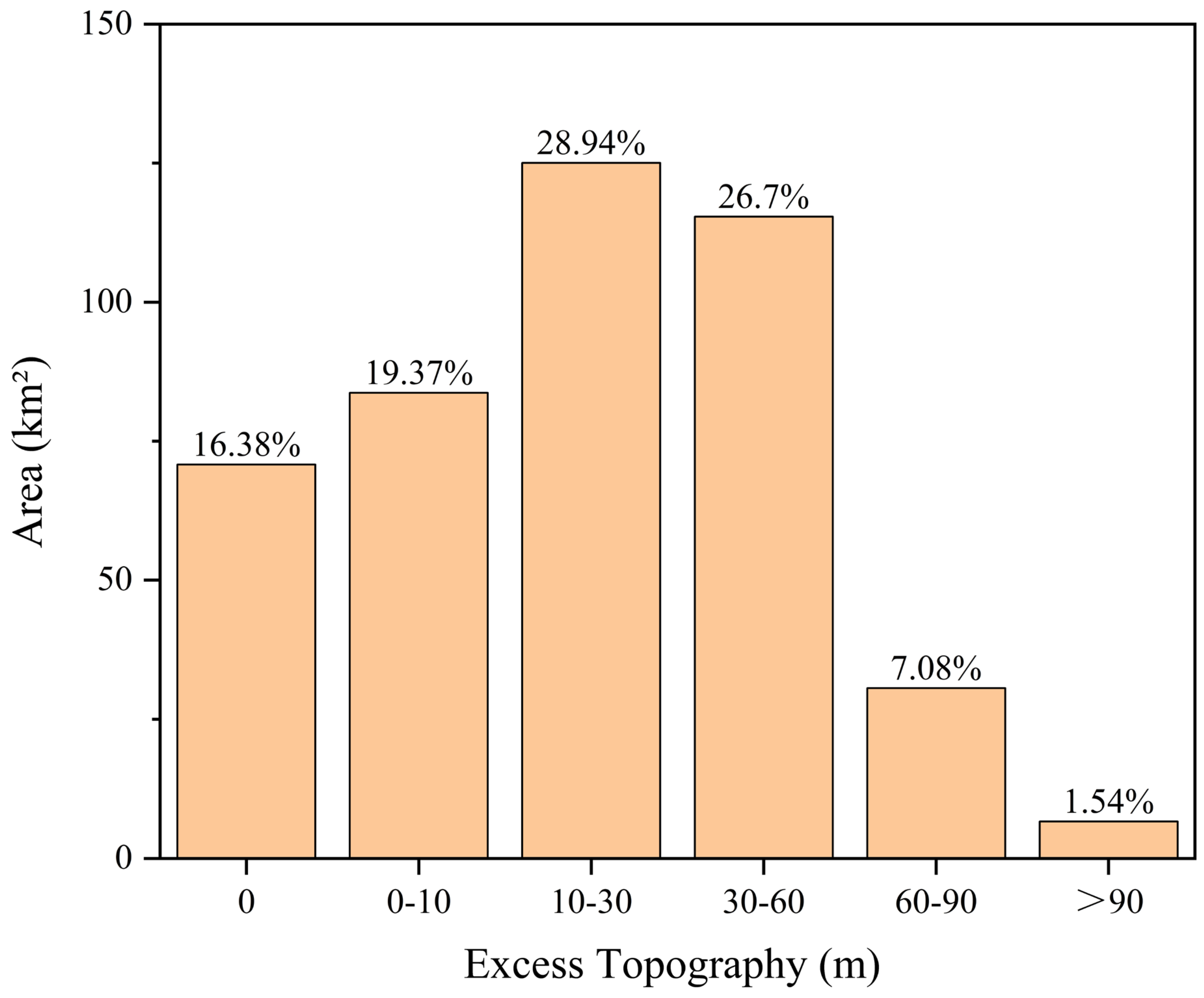
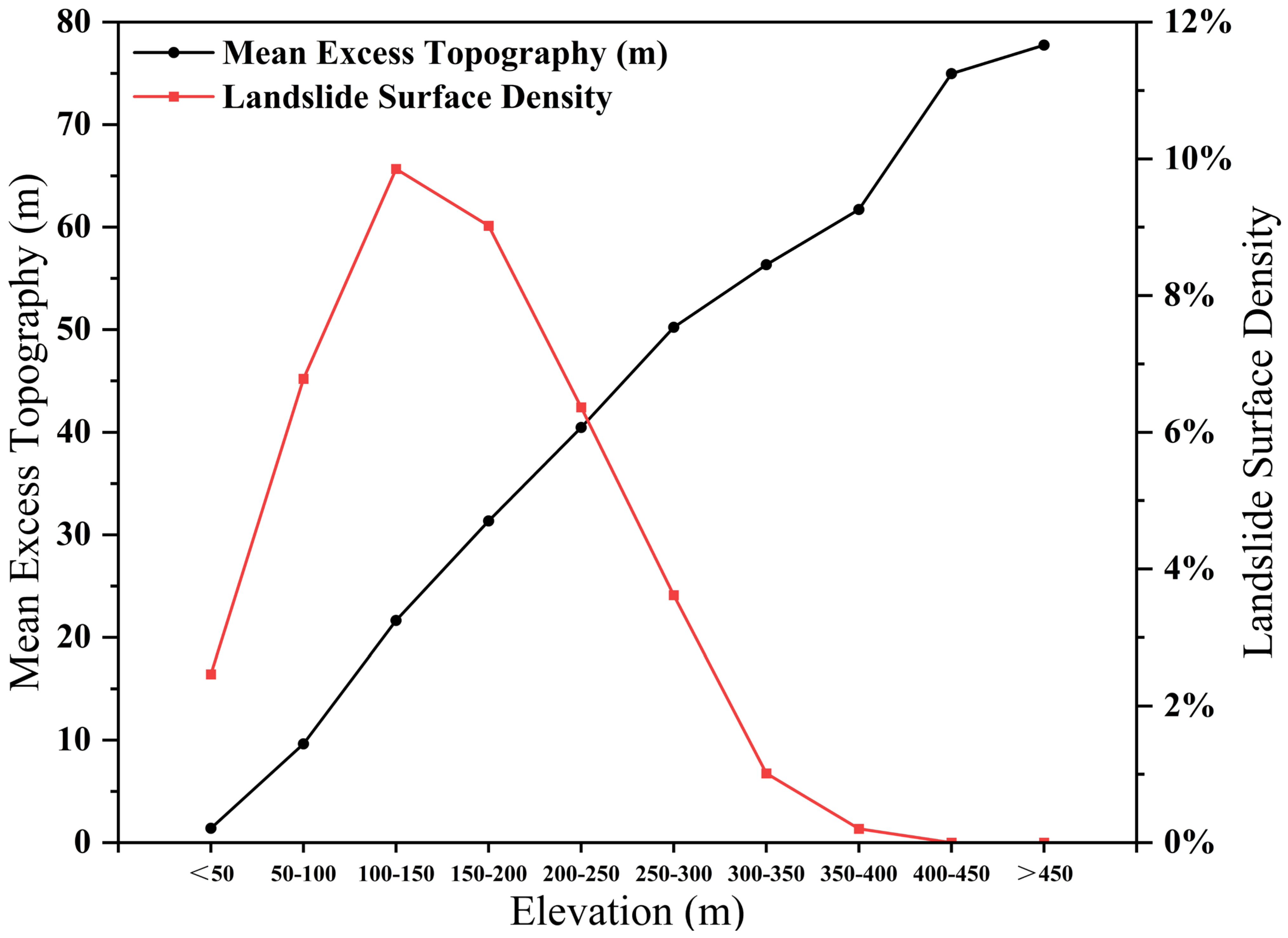
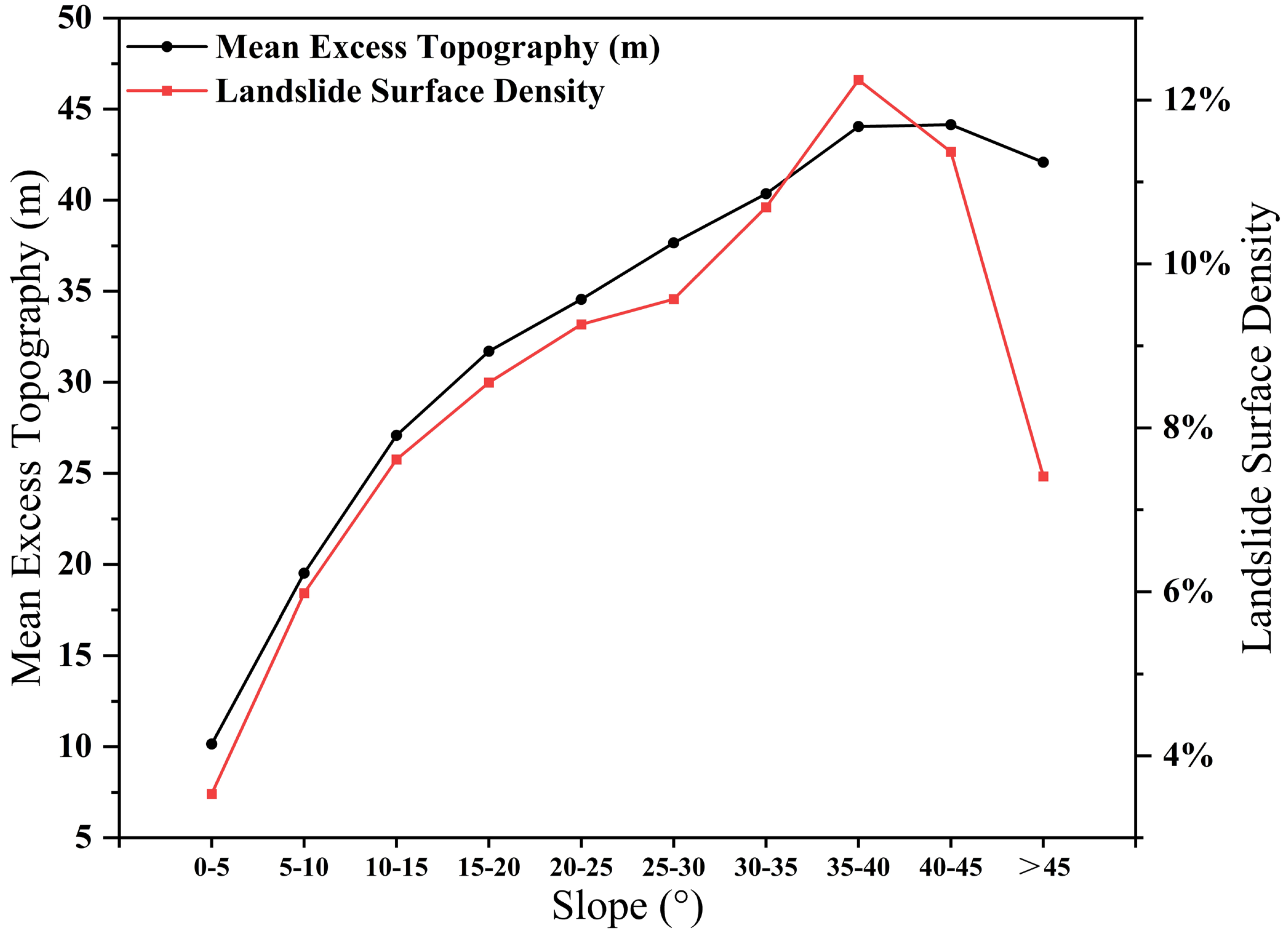

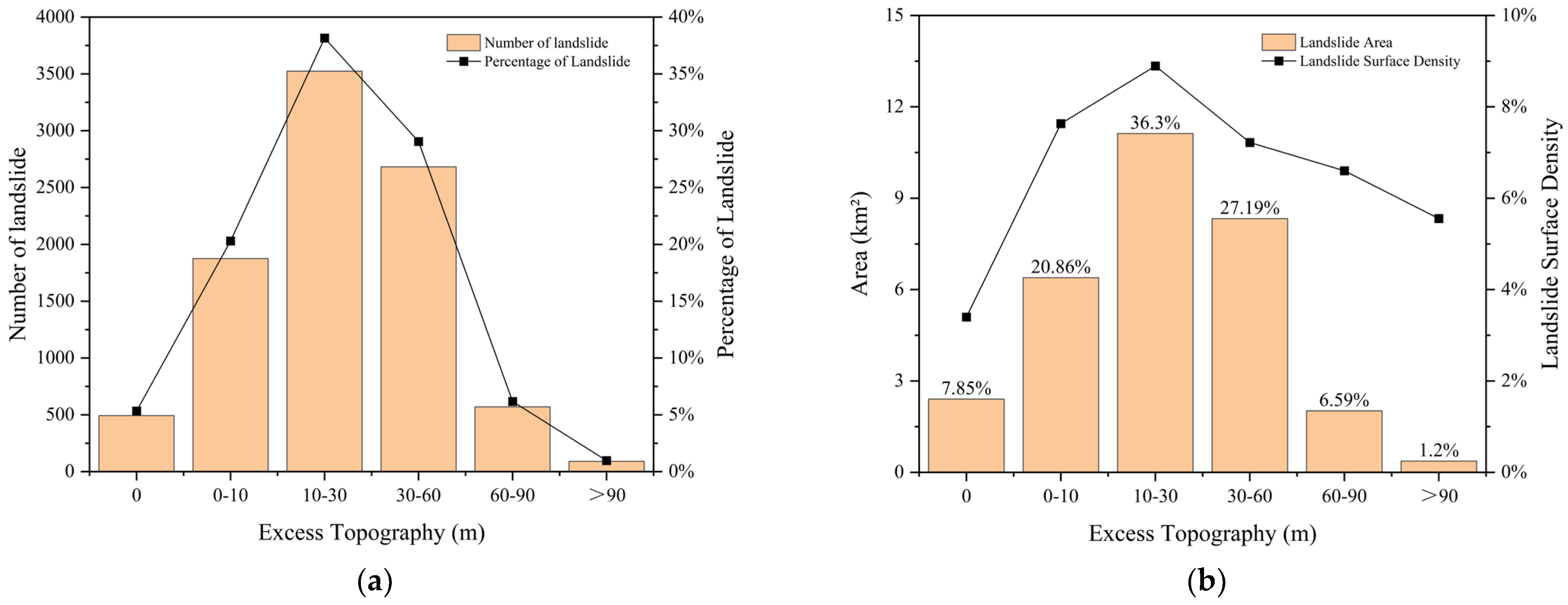
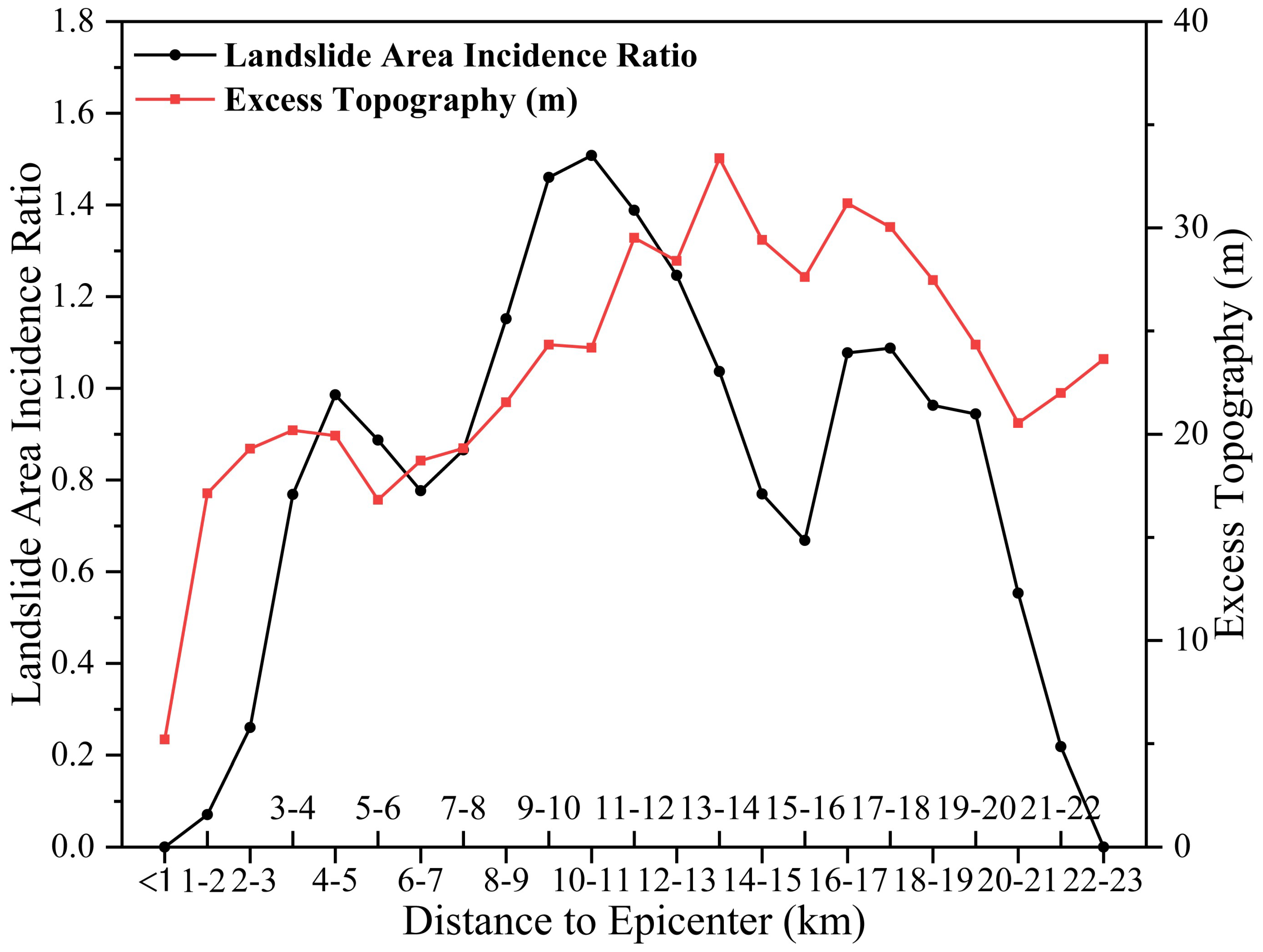
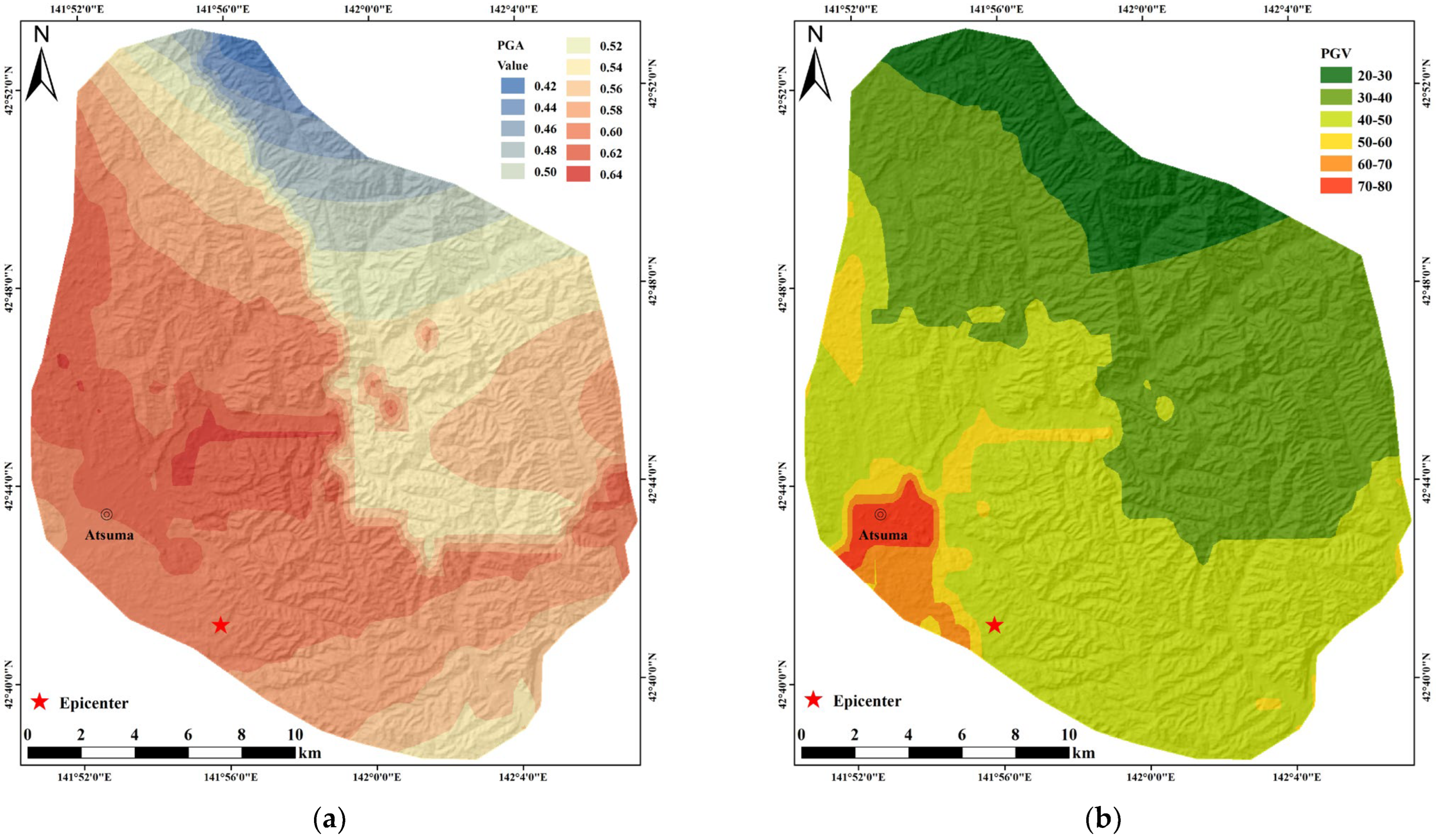
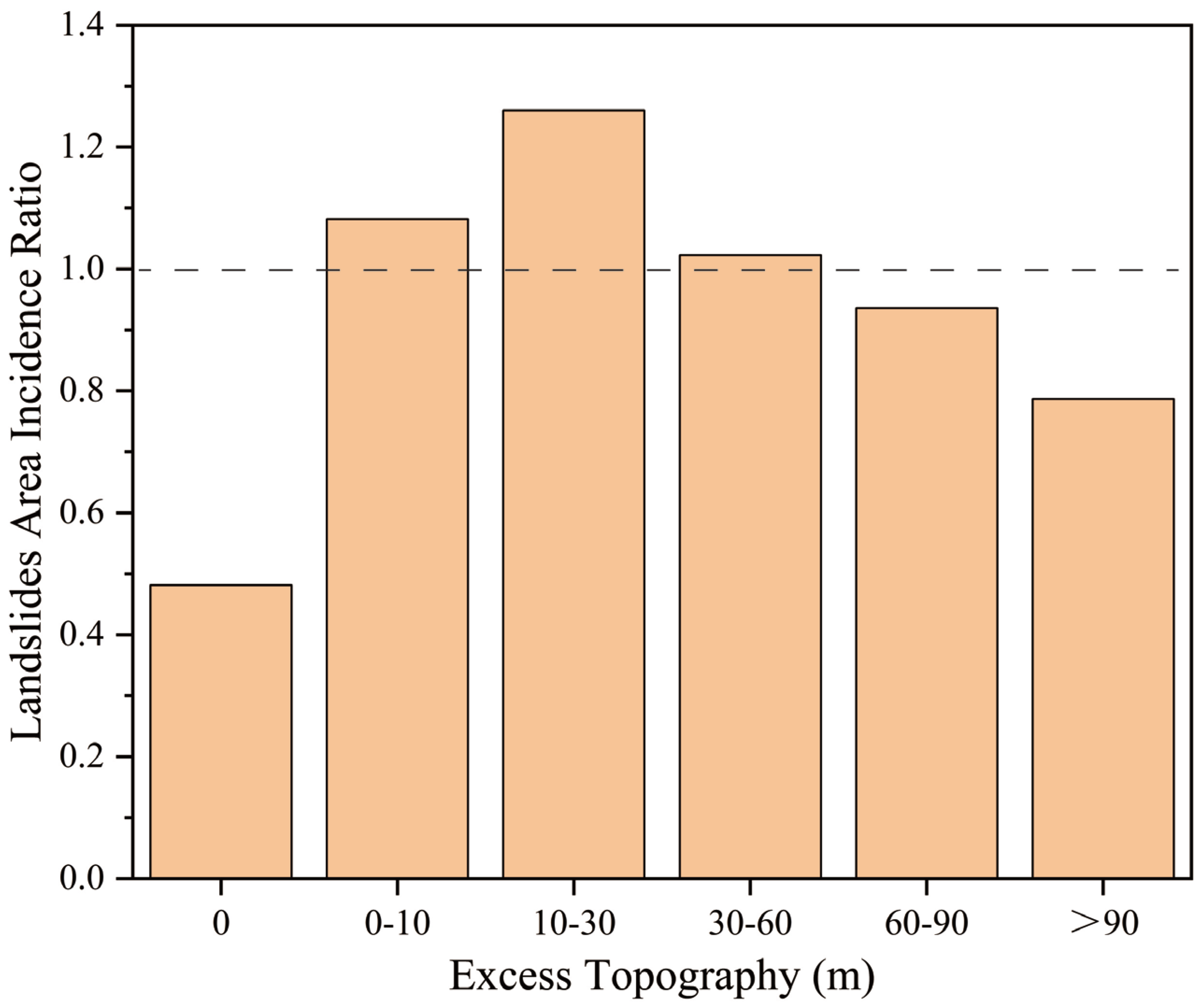

| Formation Lithology | Mean Slope (°) |
|---|---|
| Hsr | 5.77 |
| Q3tl | 15.89 |
| Q2th | 14.53 |
| Q2sr | 10.83 |
| N3sn | 5.87 |
| N2sn | 5.97 |
| N1sr | 9.17 |
| Landslide Surface Density | Excess Topography (m) | ||||||
|---|---|---|---|---|---|---|---|
| 0 | 0–10 | 10–30 | 30–60 | 60–90 | >90 | ||
| PGA (%g) | 0.42 | 0 | 0 | 0 | 0.0002 | 0.0262 | 0.0013 |
| 0.44 | 0.0261 | 0.0461 | 0.0289 | 0.0221 | 0.0089 | 0 | |
| 0.46 | 0.0402 | 0.0290 | 0.0151 | 0.0032 | 0.0013 | 0 | |
| 0.48 | 0.0320 | 0.0667 | 0.0598 | 0.0118 | 0.0021 | 0 | |
| 0.50 | 0.0374 | 0.0533 | 0.0544 | 0.0184 | 0.0024 | 0 | |
| 0.52 | 0.0811 | 0.0968 | 0.0874 | 0.0513 | 0.0531 | 0.0293 | |
| 0.54 | 0.1260 | 0.1326 | 0.1264 | 0.0983 | 0.0931 | 0.0776 | |
| 0.56 | 0.0513 | 0.0756 | 0.1002 | 0.0845 | 0.0880 | 0.0537 | |
| 0.58 | 0.0363 | 0.0435 | 0.0426 | 0.0411 | 0.0457 | 0.1374 | |
| 0.60 | 0.0266 | 0.0772 | 0.0943 | 0.0882 | 0.0951 | 0.1537 | |
| 0.62 | 0.0177 | 0.0750 | 0.1476 | 0.1957 | 0.1176 | 0.0217 | |
| 0.64 | 0.0108 | 0.0443 | 0.0330 | 0.0088 | 0.0730 | 0 | |
| Landslide Surface Density | Excess Topography (m) | ||||||
|---|---|---|---|---|---|---|---|
| 0 | 0–10 | 10–30 | 30–60 | 60–90 | >90 | ||
| PGV (cm/s) | 20–30 | 0.0354 | 0.0547 | 0.0530 | 0.0175 | 0.0062 | 0.0038 |
| 30–40 | 0.0903 | 0.1135 | 0.1208 | 0.0945 | 0.0896 | 0.0646 | |
| 40–50 | 0.0325 | 0.0641 | 0.0695 | 0.0693 | 0.0664 | 0.0840 | |
| 50–60 | 0.0051 | 0.0245 | 0.0390 | 0.0826 | 0.1088 | 0 | |
| 60–70 | 0.0006 | 0.0005 | 0 | ||||
| 70–80 | 0.0008 | 0.0030 | 0 | ||||
Disclaimer/Publisher’s Note: The statements, opinions and data contained in all publications are solely those of the individual author(s) and contributor(s) and not of MDPI and/or the editor(s). MDPI and/or the editor(s) disclaim responsibility for any injury to people or property resulting from any ideas, methods, instructions or products referred to in the content. |
© 2023 by the authors. Licensee MDPI, Basel, Switzerland. This article is an open access article distributed under the terms and conditions of the Creative Commons Attribution (CC BY) license (https://creativecommons.org/licenses/by/4.0/).
Share and Cite
Zhang, P.; Qiu, H.; Xu, C.; Chen, X.; Zhou, Q. Analysis of the Controlling Effect of Excess Topography on the Distribution of Coseismic Landslides during the Iburi Earthquake, Japan, on 6 September 2018. Remote Sens. 2023, 15, 5035. https://doi.org/10.3390/rs15205035
Zhang P, Qiu H, Xu C, Chen X, Zhou Q. Analysis of the Controlling Effect of Excess Topography on the Distribution of Coseismic Landslides during the Iburi Earthquake, Japan, on 6 September 2018. Remote Sensing. 2023; 15(20):5035. https://doi.org/10.3390/rs15205035
Chicago/Turabian StyleZhang, Pengfei, Hengzhi Qiu, Chong Xu, Xiaoli Chen, and Qing Zhou. 2023. "Analysis of the Controlling Effect of Excess Topography on the Distribution of Coseismic Landslides during the Iburi Earthquake, Japan, on 6 September 2018" Remote Sensing 15, no. 20: 5035. https://doi.org/10.3390/rs15205035
APA StyleZhang, P., Qiu, H., Xu, C., Chen, X., & Zhou, Q. (2023). Analysis of the Controlling Effect of Excess Topography on the Distribution of Coseismic Landslides during the Iburi Earthquake, Japan, on 6 September 2018. Remote Sensing, 15(20), 5035. https://doi.org/10.3390/rs15205035






